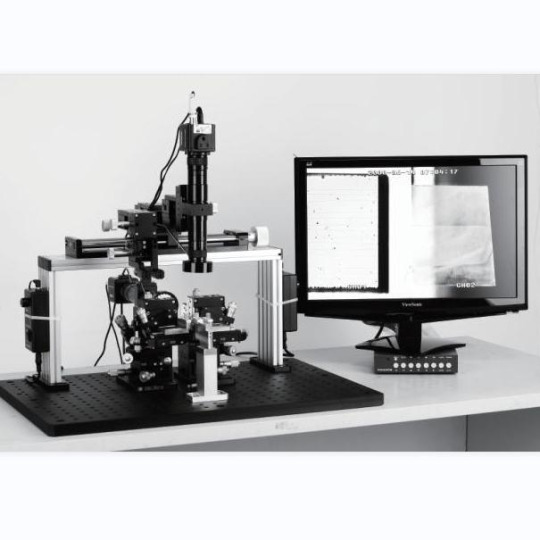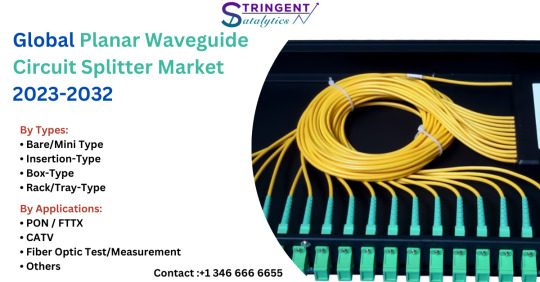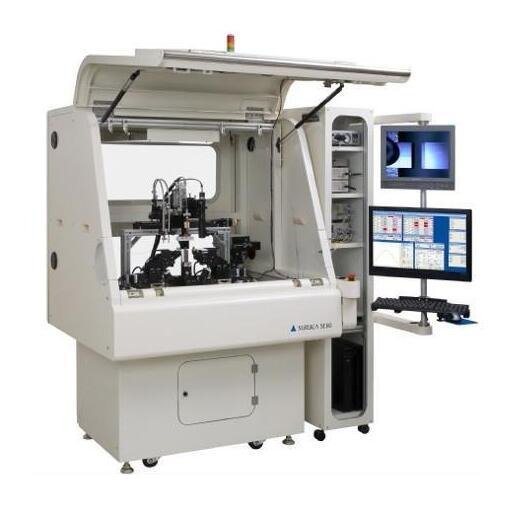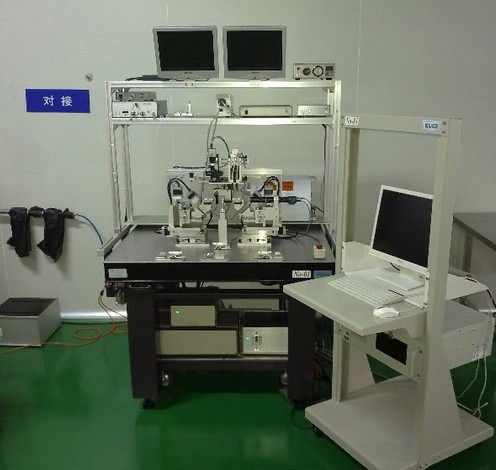#waveguide
Explore tagged Tumblr posts
Text

Using sound waves to create a smart T-shirt
Imagine wearing a T-shirt that measures your breathing or gloves that translate your hand movements into commands for your computer. Researchers at ETH Zurich, led by Daniel Ahmed, Professor of Acoustic Robotics for Life Sciences and Healthcare, have laid the foundations for just such smart textiles. Unlike many previous developments in this area, which usually use electronics, the ETH researchers rely on acoustic waves passed through glass fibers. This makes the measurements more precise and the textiles lighter, more breathable and easier to wash. "They are also inexpensive because we use readily available materials, and the power consumption is very low," says Ahmed.
Read more.
#Materials Science#Science#Sound#Smart materials#Wearable technology#Acoustics#Glass fibers#Glass#Fibers#Textiles#ETH Zurich#Waveguides
9 notes
·
View notes
Text
There's something vaguely disconcerting about the knowledge that one can stick a bunch of numbers into a circular buffer, do a little bit of feedback with averaging and it will come out sounding like a plucked string

Is this cosmic horror?
19 notes
·
View notes
Text
Chip-Scale Photonic Packaging: A New Era for Optical Fiber and Waveguide Alignment Systems
The emergence of chip-scale photonic packaging is a significant shift in optics. Manufacturers are concentrating on developing ultra-precise alignment systems to accommodate this miniaturization as the market for quicker, smaller, and more energy-efficient optical equipment expands. Here, the Optical Waveguide Alignment System and the Optical Fiber Alignment System are both being…

View On WordPress
0 notes
Text
The Global Waveguide Components and Assemblies Market Size was valued at USD 1.3 billion in 2022 and is estimated to reach USD 1.6 billion by 2027, growing at a CAGR of 4.8% during the forecast period. The market exhibits lucrative growth potential during the forecast period primarily due to the advancements in radar technologies, increased demand for microwave devices in electronic warfare systems and increasing launches of satellites and space exploration missions. Nevertheless, the requirement for new-generation warfare systems and demand for high-rate data transmission, to open several growth opportunities for Waveguide Components and Assemblies Industry during the forecast period.
#Waveguide Components and Assemblies#Waveguide Components and Assemblies Market#Waveguide Components and Assemblies Industry#Global Waveguide Components and Assemblies Market#Waveguide Components and Assemblies Market Companies#Waveguide Components and Assemblies Market Size#Waveguide Components and Assemblies Market Share#Waveguide Components and Assemblies Market Growth#Waveguide Components and Assemblies Market Statistics
0 notes
Text

Focus Microwaves W75500B waveguide tuner
Frequency range: 50-75 GHz
Waveguide type: WR-15
Standing wave ratio (VSWR) : minimum 10:1, typical 35:1
Maximum continuous wave power: 20 W
0 notes
Text

Invited talk on Design and Analysis of Waveguides at ECE Department
The Department of Electronics and Communication Engineering at K.Ramakrishnan College of Technology, in association with the IEEE Antennas and Propagation Society, recently hosted an insightful invited talk on the “Design and Analysis of Waveguides.” This event, held on featured Dr. D. Kalaiarasan, Assistant Professor, Department of Electronics and Communication Engineering, Government College of Engineering, Trichy. Nearly 120 second-year students from the department attended the session, actively participated, and immensely benefited from the expert insights shared.
#quality engineering and technical education.#krct the top college of technology in trichy#k ramakrishnan college of technology trichy#training and engineering placement#admission#Key Highlights of the Invited Talk – Design and Analysis of Waveguides#Fundamentals of Waveguides#Design Considerations#Analysis Techniques#Applications in Modern Technology#Interactive Q&A Session#Design and Analysis of Waveguides
0 notes
Text
Aerospace and Defence Head-Up Display Market - Forecast(2024 - 2030)
Aerospace and Defence Head-Up Display Market Overview
The Aerospace and Defence Head-Up Display Market size is forecast to reach $3.9 billion by 2026, growing at a CAGR of 10.5% in the period 2021-2026. The growth of the Aerospace and Defence Head-Up Display Market is mainly attributed to increased passenger traffic, which is leading to growing production of aircrafts. For instance, revenue from aircrafts exports increased from $143.17 billion in 2017 to $156.61 billion in 2019 for the U.S. The Aerospace and Defense HUD Market is anticipated to immensely benefit from emergence of smart devices such as Garmin Head up Display (HUD) and SmartView Synthetic Vision, which has further elevated demand for head up displays in the aerospace sector. The need for improved aircraft steering, Instrument landing system have propelled the adoption of Synthetic vision systems such as Aerospace and Defense HUD.
Aerospace and Defence Head-Up Display Market Report Coverage
The report: “Aerospace and Defence Head-Up Display Market Industry Outlook – Forecast (2021-2026)”, by IndustryARC, covers an in-depth analysis of the following segments of the Aerospace and Defense HUD Market.
By Technology: CRT, LED, MEMS, Optical Waveguide and Others. By Components: Video Generator, Projection Unit, Display Unit, Combiners and Others. By Application: Aerospace (Aircraft, Helicopters and UAVs), Defense (Air, Ground, Marine and Others). By End Use Industry: Civil, Military and Government and Others. By Geography - North America (U.S, Canada, Mexico), Europe (Germany, UK, France, Italy, Spain, Russia and Others), APAC(China, Japan India, South Korea, Australia and Others), South America(Brazil, Argentina and others)and RoW (Middle east and Africa).
Request Sample
Key Takeaways
Key players including BAE Systems, Thales Group, Collins Aerospace, Elbit Systems and Excelitas Technologies Corp accounted for around 70% of the total market share in 2018, with contracts and partnerships being adopted as key strategies.
The major driving factor in the Aerospace and Defense HUD Market is increased investments in the aerospace sector during the forecast period. In this sector, head up displays are being deployed to aid pilots in estimating the path of the aircraft and thereby enhancing flight control and aircraft steering through synthetic vision systems. This has compelled aircraft manufacturers to integrate advanced features such as head-up display in aircrafts which improve Display luminance.
Head up displays are being majorly deployed in small and mid-size aircrafts owing to their compactness, high accuracy sensors and cost efficient relay optics that are used to project the HUD image to the pilot. This has driven demand for projector units which hold the largest market share of around 25% in the components segment.
North America is the largest market for Aerospace and Defense HUDs, accounting for around 43% of the global market share in 2020 owing to increased demand for precise situational awareness in military aircrafts. The head up displays deploy an algorithm to calculate the optimum flare maneuver required for ensuring a smooth landing on the runway. This feature helps pilots avoid stressful maneuvers on unfamiliar sloped runways or during nighttime approach landings.
Aerospace and Defence Head-Up Display Market Segment Analysis – By Technology
Optical waveguide head up displays is a major segment, accounting for around 62% in the Aerospace and Defense HUD market globally in 2020. They find application in the aviation sector owing to the advantages they offer in terms of data projection, easy installation and cost efficiency. In recent years, increased investments in the aerospace sector globally have fuelled demand for head up displays for aircraft steering and instrument landing systems. The U.S. has encouraged NATO countries to expand their aerospace and military expenditure. As a result of this, in 2019, the government of France has announced expansion of its military and aerospace expenditure to 2% of GDP. Moreover, the U.K. Ministry of Defense signed a deal with California-based General Atomics worth $125m to supply drones equipped with head up displays for the U.K. defense sector.
Inquiry Before Buying
Aerospace and Defence Head-Up Display Market Segment Analysis – By End Use Industry
One of the significant growth factors for the Aerospace and Defense HUD market is the deployment of HUDs in civil aircrafts. The civil aviation segment for the Aerospace and Defense HUD market is poised to grow at a CAGR of 13.2% in the forecast period 2021-2026. Research is being carried out to design innovative HUD interfaces aiming to reduce operator distraction and improve performance. Boeing has introduced its 787 advanced flight deck, incorporating head up displays, that integrates dual global positioning system receivers with triple-redundant flight management systems that enhances precise flight vision through aircraft steering and instrument landing systems. Additionally, recently issued regulations have significantly fuelled demand for head up displays in the aerospace arena. Civil Aviation Administration of China has mandated adoption of head up displays to facilitate enhanced projection of data in Chinese airlines by 2025. Such initiatives have propelled demand for head up displays in the aerospace sector.
Aerospace and Defence Head-Up Display Market Segment Analysis – By Geography
North America holds a dominant share of 43% in the head up display market in 2020, which can be attributed to increased investments in the aerospace sector. According to the Aerospace Industries Association, aerospace exports in U.S. have increased by 26% from $113 billion in 2012 to $154 billion in 2019. In 2019, the Canadian Department of National Defense awarded a contract worth $14.5m to Marconi Aerospace Defense Systems to develop and integrate vision imaging systems and head-up displays for the Canadian CH-146 Utility Tactical Transport Helicopter (UTTH). Developments such as these present excellent growth opportunities for the Aerospace and Defense HUD market in the North American region.
Aerospace and Defence Head-Up Display Market Drivers
Increased Investments In The Aerospace Sector
In the military and defense aviation sector, there has been a significant increase in the deployment of head up displays. This rise is attributed to the capability of HUDs to direct the pilot’s vision outside the aircraft and provide all the necessary flight information to the pilot. This results in an increase in overall efficiency and safety, which are essential considerations for the defense and military sectors. Moreover, demand for real-time monitoring of data by on-board instruments such as head up displays for improved aircraft steering and instrument landing systems in military aircrafts has consequently led to increased investments for deployment of head up displays in the aerospace sector. For instance, the Italian Ministry of Defense increased its investment on surveillance drones from $506m in 2016 to $991m in 2019. These drones incorporate head up displays, which is consequently boosting demand for head up displays in the aerospace sector.
Schedule a Call
Rise In Production Of Civil Aircrafts
As per the International Air Transport Association, passengers travelling by domestic airlines globally increased from 561 billion in 2018 to 589 billion in 2019. The rise in passenger traffic globally has subsequently called for an increase in production of civil aircrafts. According to the International Air Transport Association (IATA), approximately 39,000 aircrafts are estimated to be produced by 2027. This is anticipated to significantly increase demand for head up displays in civil aircrafts. Moreover, companies are focusing on developing innovative head up displays for enhancing precision within aircrafts. Netherlands-based Airbus SE has been developing an enhanced flight vision system (EFVS) to be equipped on its aircrafts still under production. This research is aimed at improving airport access for aircrafts, with the help of head up displays, regardless of weather or landing aids on the ground.
Aerospace and Defence Head-Up Display Market Challenges
System Delays
In military applications, head up displays need to display the relevant information within a desired time frame. However, system delays often occur as a result of several factors including sensor delay, system processing speed and display update rate. Regardless of the source, the overall system delay results in the presentation of information that is inconsistent with the aircraft’s current state, further leading to errors in flight operation and reduced overall efficiency.
Buy Now
Aerospace and Defence Head-Up Display Market Landscape
Partnerships and acquisitions along with contracts and up gradation are key strategies adopted by players in the Aerospace and Defense HUD market. In 2018, the market for the Aerospace and Defense HUDs remained consolidated, with the top 10 players accounting for approximately 90% of market share. The major players in the Aerospace and Defense HUD Market include BAE Systems, Thales Group, Collins Aerospace, Elbit Systems, Excelitas Technology Corp, Honeywell Aerospace and Garmin Ltd.
Partnerships/Product Launches/Contracts
In July 2019, Leonardo S.p.A. signed a contract worth €300mwith the Armaments and Airworthiness Department of the Italian Ministry of Defense, aimed at supplying 13 M-345 High Efficiency Trainers (HET) equipped with head up displays.
In February 2019, Continental AG increased its investment in DigiLens Inc. from the $25m it had invested in 2016. This investment is targeted at developing a waveguide head up display that fulfills requirement of applications across industries such as aerospace, automotive and others.
#Aerospace and Defence Head-Up Display Market#SmartView Synthetic Vision#Aerospace and Defence Head-Up Display Market size#Optical Waveguide#Aerospace and Defence Head-Up Display industry#Aerospace and Defence Head-Up Display Market share#Aerospace and Defence Head-Up Display top 10 companies#Aerospace and Defence Head-Up Display Market report#Aerospace and Defence Head-Up Display industry outlook
0 notes
Text
Microwave waveguides are crucial components in the field of microwave engineering, facilitating the transmission of high-frequency electromagnetic waves with minimal loss. They are indispensable in a variety of applications, ranging from telecommunications and radar systems to medical equipment and satellite communications. Understanding the intricacies of microwave waveguides can provide valuable insights into their functionality, types, applications, and advantages.
What are Microwave Waveguides?
Microwave waveguides are structures that guide electromagnetic waves, typically in the microwave frequency range, from one point to another. Unlike coaxial cables or transmission lines, which carry both electric and magnetic fields in a dielectric medium, waveguides confine and direct the wave using a hollow metallic or dielectric structure. This confinement leads to higher efficiency and lower loss at microwave frequencies.
Types of Microwave Waveguides
Rectangular Waveguides: The most common type, rectangular waveguides, have a rectangular cross-section. They support the TE (Transverse Electric) and TM (Transverse Magnetic) modes of propagation, with the TE10 mode being the dominant and most efficient one.
Circular Waveguides: These have a circular cross-section and support both TE and TM modes, as well as hybrid modes. Circular waveguides are often used in applications requiring rotational symmetry.
Elliptical Waveguides: Elliptical waveguides are used when the application requires specific polarization characteristics. They are less common than rectangular and circular waveguides but are essential in specialized applications.
Flexible Waveguides: These waveguides are constructed from materials that allow them to bend and flex, making them ideal for applications where rigid waveguides cannot be used due to space constraints.
Ridged Waveguides: Adding ridges inside the waveguide structure can increase the bandwidth and lower the cutoff frequency, making ridged waveguides suitable for wideband applications.
1 note
·
View note
Text
The Waveguide Components and Assemblies Market is projected to grow from USD 1.3 billion in 2022 to USD 1.6 billion by 2027, at a CAGR of 4.8%.
The market exhibits lucrative growth potential during the forecast period primarily due to the advancements in radar technologies, increased demand for microwave devices in electronic warfare systems and increasing launches of satellites and space exploration missions. Nevertheless, the requirement for new-generation warfare systems and demand for high-rate data transmission, to open several growth opportunities for Waveguide Components and Assemblies Industry during the forecast period.
#Waveguide Components and Assemblies#Waveguide Components and Assemblies Market#Waveguide Components and Assemblies Industry#Global Waveguide Components and Assemblies Market#Waveguide Components and Assemblies Market Companies#Waveguide Components and Assemblies Market Size#Waveguide Components and Assemblies Market Share#Waveguide Components and Assemblies Market Growth#Waveguide Components and Assemblies Market Statistics
0 notes
Text

One glass, full color: Sub-millimeter waveguide shrinks augmented-reality glasses
Augmented-reality (AR) technology is rapidly finding its way into everyday life, from education and health care to gaming and entertainment. However, the core AR device remains bulky and heavy, making prolonged wear uncomfortable. A breakthrough from POSTECH now promises to change that. The study is published in the journal Nature Nanotechnology. One of the main hurdles to the commercialization of AR glasses has been the waveguide. In AR optics, the lens itself also serves as a "highway of light," guiding virtual images directly to the user's eye. Due to chromatic dispersion, conventional designs have required separate waveguide layers for red, green, and blue light—three to six stacked glass sheets—inevitably increasing both weight and thickness.
Read more.
5 notes
·
View notes
Text
Planar Waveguide Circuit Splitter Market

0 notes
Text
Optical Fiber Alignment Systems Are Revolutionizing Next-Gen Communication Networks

Precision is crucial in the ever changing field of communication technology. The need for quicker, more dependable connections is only increasing, whether it is via 5G networks, high-speed internet, or data centres that fuel the cloud. The Optical Fiber Alignment System is a quiet but significant invention that is working behind the scenes.
An optical fibre alignment system: what is it?
A high-precision method for aligning optical fibres with nanometre accuracy is called an optical fibre alignment system. By ensuring that the cores of two fibres are precisely aligned, these systems reduce insertion loss and increase signal strength. Even the most sophisticated fibre networks will experience inefficient transmission in the absence of precise alignment.
Why is Alignment Important?
Networks are under more strain than ever before due to the exponential increase in data consumption—think video streaming, remote work, IoT, and AI. Accurately aligning optical components has a direct impact on:
Transmission Speed: Data transport may be slowed down by misalignment.
Signal Quality: Signal loss is decreased by precise alignment.
Network Reliability: Outages and error rates are increased by faulty connections.
Optical Waveguide Alignment System
The Optical Waveguide Alignment System goes beyond conventional alignment, which just considers fibres. It is intended to align integrated photonic waveguides as well as optical fibres, which are crucial parts of photonic chips that manage light-based data transfer on a micro scale.
These systems are necessary in:
Faster, smaller, and more energy-efficient circuits are made possible via silicon photonics.
In quantum computing, accuracy cannot be compromised.
Advanced Sensing: When photonic integration is needed in aeronautical or healthcare applications.

Optical Waveguide Alignment Systems are driving innovation in a variety of sectors by guaranteeing nearly flawless coupling between fibres and waveguides. The foundation of tomorrow's communication infrastructure is made up of Optical Fiber Alignment System and optical waveguide alignment systems, which may enhance the quality of your video conversations and enable cutting-edge technologies like photonic chips and quantum computing.
Next: PM Fiber Patch Cables: What They Are and Why They Matter
1 note
·
View note
Text
Space Machine

Space Machine is a global leader of Waveguide run design, RF solutions, components and assemblies. Our experts are on your side as we work through all aspects of component requirements for a successful mission. We help ensure your design, prototype testing and manufacturing are executed to the highest precision and technical specifications.
Space Machine & Engineering makes custom waveguides, horn antennas, assemblies and waveguide components. Established in 1962, we are a leading waveguide manufacturer and offer design, installation, testing and targeting for commercial and military applications.
Visit Our Website
#horn antennas#standard gain horn antennas#waveguide horn antenna#standard gain horn#waveguide horns
0 notes
Text
The Waveguide Components and Assemblies Market is projected to grow from USD 1.3 billion in 2022 to USD 1.6 billion by 2027, at a CAGR of 4.8%.
The market exhibits lucrative growth potential during the forecast period primarily due to the advancements in radar technologies, increased demand for microwave devices in electronic warfare systems and increasing launches of satellites and space exploration missions. Nevertheless, the requirement for new-generation warfare systems and demand for high-rate data transmission, to open several growth opportunities for Waveguide Components and Assemblies Industry during the forecast period.
#Waveguide Components and Assemblies#Waveguide Components and Assemblies Market#Waveguide Components and Assemblies Industry#Global Waveguide Components and Assemblies Market
0 notes
Text
Optical Waveguide Market Size Worth USD 13.70 Billion by 2027
The global Optical Waveguide Market is forecasted to reach USD 13.70 Billion by 2027, according to a new report by Emergen Research. The optical waveguide market is expected to expand significantly due to the growing demand for higher bandwidth and fast cloud computing adoption by various data centers.
0 notes